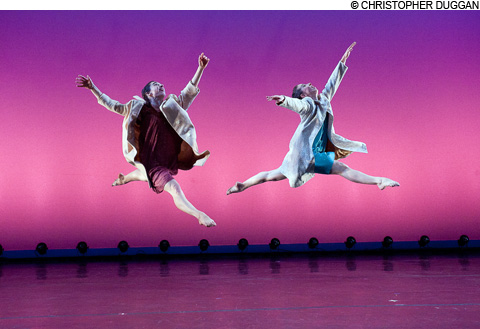
THAT’S ENTERTAINMENT! Monica Bill Barnes’s dances assemble material from vaudeville, TV gags, cheerleading, and rickety hand-me-down stunts. |
When the audience entered the theater at the ICA on Friday night, we saw a wooden table and chairs, set up for a simple meal — possibly breakfast. Pop records played softly. The house lights went out, and then two people in raincoats and bare feet appeared, standing on the table. One step at a time, they swayed gently, tracing a box step but not touching, except when they snapped into jagged lifts, perilously close to the edge of the table.Suddenly Summer Somewhere, opening the concert by Monica Bill Barnes & Company last weekend (presented by CRASHarts), signaled Barnes's wry take on popular culture. The somnambulists (Barnes and Anna Bass) descend from the table to dance a routine that slides from a foxtrot to a pocket-size chorus line and back again. Frank Sinatra sings a Rodgers & Hammerstein tune, "I Have Dreamed," stretching out the climaxes and pressurizing the high notes with operatic swagger. Barnes has taxied from surrealism to understated comedy and displays of manufactured ego.
In Mostly Fanfare Barnes and Bass, joined by Christina Robson, are a trio of performers in a show that may still be in rewrites. They scoot down a diagonal in perfect unison, jogging with tiny steps, elbows out, their half-clenched fists hugging their hip bones. When they get to the downstage end of the diagonal, they jog backwards to the upstage corner and start again. There's something dogged and charming about this. When Bass falls behind, the others take no notice. Bass tries to make her faux pas look intentional.
Bass gets a big solo to do when Barnes and Robson have trundled away, but she's soon beset by a cascade of large cardboard boxes thrown at her from nowhere. Shoulders drooping slightly, she shoves each new delivery out of the way and dances on. Finally there are so many boxes, she has to stack five or six of them and carry them off. What's left is cleared away by two burly, stoic stagehands. Then all three women return for a specialty act requiring them to balance chairs in their teeth.
The evening continues with a string of coups de théâtre and underplayed punchlines. While the trio are off exchanging their camisoles, miniskirts, and ostrich plumes for men's suits and ties, Giulia Carotenuto vamps listlessly as the stagehands execute another scene shift. The dance that follows, Everything is getting better all the time, rises to many anti-climaxes, enhanced by appealing expressions and toothy smiles.
In these three dances Barnes isn't just clowning around. Starting with subtle, nearly inert shadow-gestures, she assembles material from vaudeville, TV gags, cheerleading, rickety hand-me-down stunts — an encyclopedia of useable gambits. Each dance is accompanied by selections from a different pop singer: Sinatra, Nina Simone, and Otis Redding. The stars rip into soulful ballads, shamelessly egging on their audiences with virtuosic riffs and vocal exertions.
Barnes and company try just about everything to rouse their audience, including yanking off their shirts and jackets — they have jerseys underneath. Their dancing gets a little desperate, their tricks brassier. No matter how inane their task, they give it their best. Their grins get broader. They wink at the audience. They're letting us in on their jokes — and on their embarrassment for how pitiful the jokes are. We chuckle. We laugh. We fall in love with them.